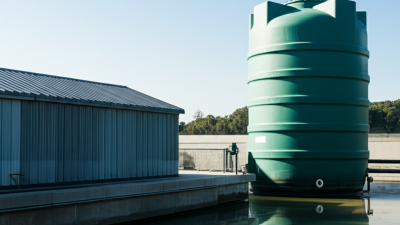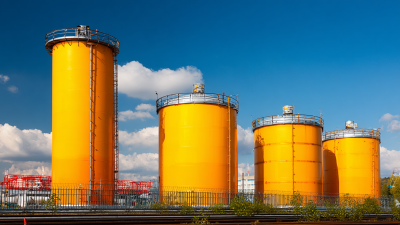When it comes to water storage solutions, finding the right fit for your needs is crucial, and a large plastic water tank can be an excellent choice. These tanks are not only durable and cost-effective but also versatile for various applications, from agriculture to household use. In this guide, we will delve into essential tips and considerations that can help you make informed decisions when choosing a large plastic water tank.

We will explore key factors such as tank capacity, material quality, installation requirements, and maintenance practices, enabling you to maximize your water storage efficiently. Whether you’re looking to store rainwater, ensure a steady supply for your garden, or have a reliable water source for emergencies, understanding these elements will empower you to select the best large plastic water tank tailored to your specific needs.
When choosing a large plastic water tank, understanding your water storage needs is crucial. Assessing your household usage, seasonal changes, and emergency water requirements will help you determine the appropriate size. For instance, an average family may require around 80-100 gallons per day, factoring in cooking, drinking, bathing, and gardening. If you live in an area prone to droughts or severe weather, it’s wise to consider a larger tank to ensure a sufficient supply during critical periods.
Additionally, take into account the potential for future needs as well. If you plan to expand your family or increase water usage with additional landscaping or livestock, opt for a tank that offers extra capacity. Evaluate your available space and the tank’s dimensions to ensure a proper fit, as well as checking any local regulations regarding water storage. With a clear understanding of these factors, you'll be better equipped to select a plastic water tank that meets your requirements effectively.
When considering large plastic water tanks for your storage needs, it's essential to evaluate the material's pros and cons.
Plastic tanks, often made from polyethylene or polypropylene, are lightweight, durable, and resistant to corrosion.
However, they can be vulnerable to UV damage, which may result in degradation over time if not properly covered or coated with UV-resistant solutions.
Tips: When selecting a plastic water tank, always check for UV-stabilized options, especially if your tank will be exposed to sunlight.
Regular inspections for any signs of wear or cracks can prevent leaks and prolong the lifespan of your tank.
Another aspect to consider is the potential for chemical leaching. While most food-grade plastic tanks minimize this risk,
it is crucial to ensure that the tank you choose is certified for potable water storage. This ensures that your water remains safe for consumption and free from contaminants.
Tips: Look for tanks that come with a manufacturer's warranty; this can indicate the quality and reliability of the tank.
Additionally, consider the tank's size and shape to ensure it meets your specific storage requirements while fitting within your space constraints.
When selecting a large plastic water tank, certain features are crucial for maximizing durability and efficiency. UV resistance, for instance, plays a vital role in extending the lifespan of the tank. According to a report by the Water Quality Association, tanks that incorporate UV stabilization can last up to 25% longer than those that do not. This is essential in regions with high sun exposure, where prolonged UV exposure can cause the material to degrade and compromise the tank’s integrity.
Another key feature is rust prevention, pivotal for maintaining clean and safe water storage. While plastic tanks are generally immune to rust, it's important to ensure that all fittings and components used in conjunction with the tank are also rust-resistant. A study by the American Society of Civil Engineers highlighted that non-corrosive materials significantly reduce contamination risks, making the water supply safer over time. Opting for tanks with additional protective coatings can provide an extra layer of security against environmental factors that contribute to wear and tear. By focusing on these features, users can make informed decisions that ensure their water storage systems are both reliable and resilient.
When it comes to installing a large plastic water tank, adhering to best practices is essential for ensuring efficiency and longevity. First and foremost, proper site selection plays a crucial role in the installation process. The area should be level and stable, away from any sources of contamination such as chemicals or waste. Additionally, making sure that the tank is positioned close to the intended usage site can minimize the need for extensive plumbing, reducing both time and costs.
Moreover, integrating sustainable water treatment practices during installation can enhance the functionality of your water tank. Utilizing filters and treatment systems that are compatible with your tank not only ensures clean water storage but also fosters better health and safety standards. It’s important to consider decentralized infrastructure solutions that facilitate easy access and distribution of water, especially in rural or undeveloped regions. These practices not only maximize the capacity of your water tank but also support overall environmental sustainability while addressing pressing flood prevention measures.
Proper maintenance of large plastic water tanks is essential for ensuring their longevity and efficiency. According to a report by the American Water Works Association, poorly maintained water storage systems can lead to significant water quality issues, with bacteria and sediment buildup being common problems. Regularly inspecting and cleaning your tank can mitigate these risks. Experts suggest that, ideally, tanks should be cleaned every 6 to 12 months, depending on the local environment and usage.
Additionally, monitoring the tank’s structural integrity is crucial. A study by the National Sanitation Foundation highlights that cracks or leaks can reduce storage capacity by up to 30%, allowing contaminants to enter the system. It’s advisable to regularly check for any signs of wear or damage and address issues promptly. Using protective coatings and proper installation techniques can further enhance the tank’s durability, extending its lifespan significantly. By following these maintenance tips, you can ensure that your large plastic water tank remains efficient and provides safe water for many years to come.






